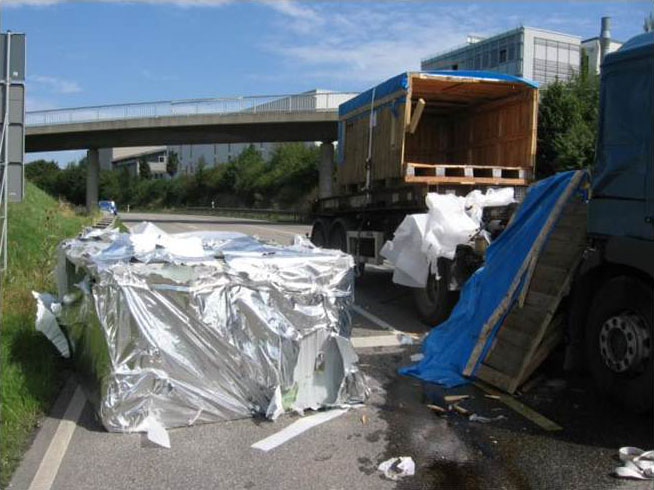| Photo of the month – October 2011 |
[German version] |
Gatecrashing
Of course, nobody here has come gate crashing a party, but even so, a heavy machine has crashed out onto the highway. And this event was equally as surprising as any gatecrasher would have been as they came thundering through a splintering door.

Figure 1 [Daniel Sturm]
This did not happen as the result of a rear-end collision or an emergency braking maneuver. This event happened merely because the driver braked to slow down.
The load itself was a press used for bending sheet metal. The weight of the load was given as 15 tonnes. The silver foil wrapped around the load itself forms part of a sealed package designed to protect against corrosion and made up of a composite polyethylene and aluminum film. This event, which ultimately culminated in an accident, furnishes excellent proof that load securing must be an end-to-end process and must be thought through in rigorous detail.
Machines or machine components, and anything stowed in boxes and presented for transport must be connected to the floor of the box by means of a tight fit or by friction securing. Securing by means of a tight fit establishes a connection between the floor of the box or crates and the packaged goods. The bolts must pass through the longitudinal skids. It is possible that the longitudinal skids must be arranged in such a way that this becomes possible. If it is not possible to bolt the load, it must be secured by lumber. This securing lumber must be securely bolted to the longitudinal skids. As a rule, additional securing is also necessary in the form of pressure blocks (friction securing). One way of doing this is to use cut-lumber clamps with threaded rods. These cut-lumber clamps are passed over parts of the packaged goods that are capable of withstanding loads and bolted to the longitudinal skids of the box on both sides.
You will find additional information on building boxes and crates under www.verpackungshandbuch.de or here at www.tis-gdv.de und by following the link to the Packaging Handbook. This Packaging Handbook is available free of charge on the Internet.
We would draw particular attention to the definition of the term „Fit-for-purpose packaging“ on page 19 or in section 1 in the Internet version. Here we see that „packaging is fit for purpose if it ensures that the packaged goods arrive at the recipient undamaged, taking into consideration the shipping loads, shipping distance, shipping duration and the transport load profile.“
Back to beginning
